Key takeaways:
- Understanding speaker conflicts involves balancing emotional investments, audience needs, and logistical challenges.
- Effective communication and transparency build trust and foster future collaboration among speakers.
- Setting clear expectations and boundaries enhances preparation and reduces potential conflicts.
- Documenting agreements ensures accountability and strengthens relationships, facilitating reflection and improvement post-event.
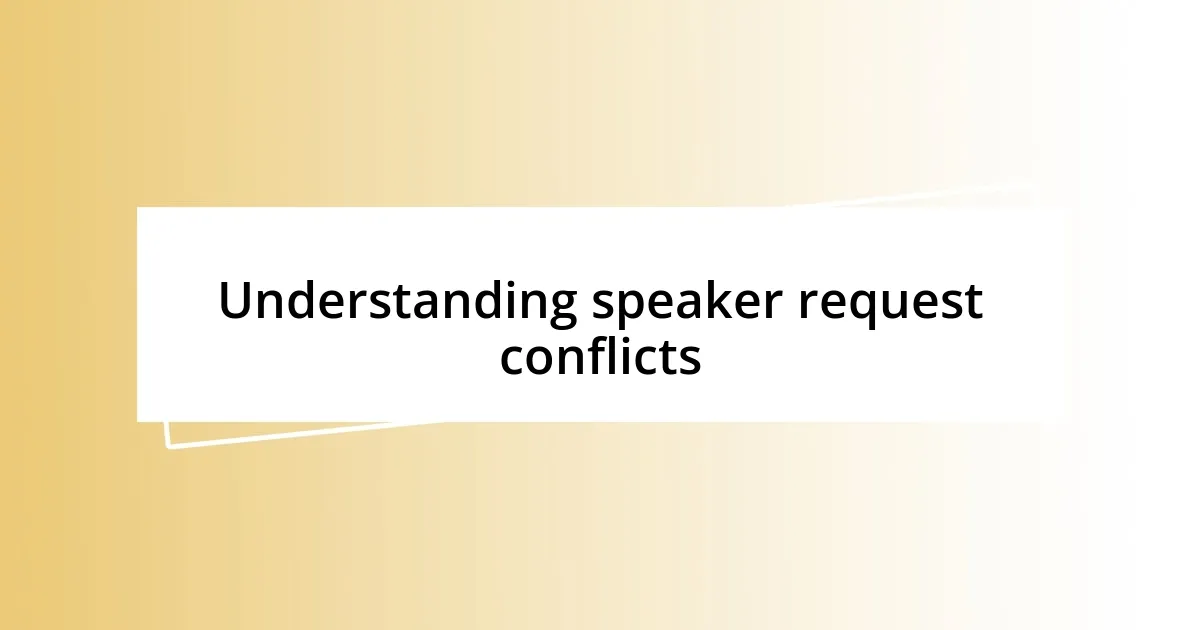
Understanding speaker request conflicts
Understanding speaker request conflicts can be quite intricate, as they often arise from competing priorities and logistical challenges. I remember a time when I had to choose between two exceptional speakers for a single event – both of whom had passionate followings. It was heartbreaking to think about letting one down while prioritizing the other.
What makes these conflicts particularly challenging is the emotional investment of both the speakers and the audiences involved. I once felt the pressure of a last-minute scheduling change that not only affected the speakers’ plans but also created anxiety among attendees who were excited to hear from them. Have you ever faced a similar situation where balancing expectations felt like a tightrope walk?
In trying to navigate these conflicts, I’ve learned that communication is key. When I clearly explain the reasons behind my choices to the speakers involved, it often helps to ease their disappointment. The emotional side of these decisions isn’t just about logistics; it’s about maintaining relationships and fostering goodwill for future collaborations. Reflecting on these experiences, I realize how vital it is to handle each situation with empathy and understanding.
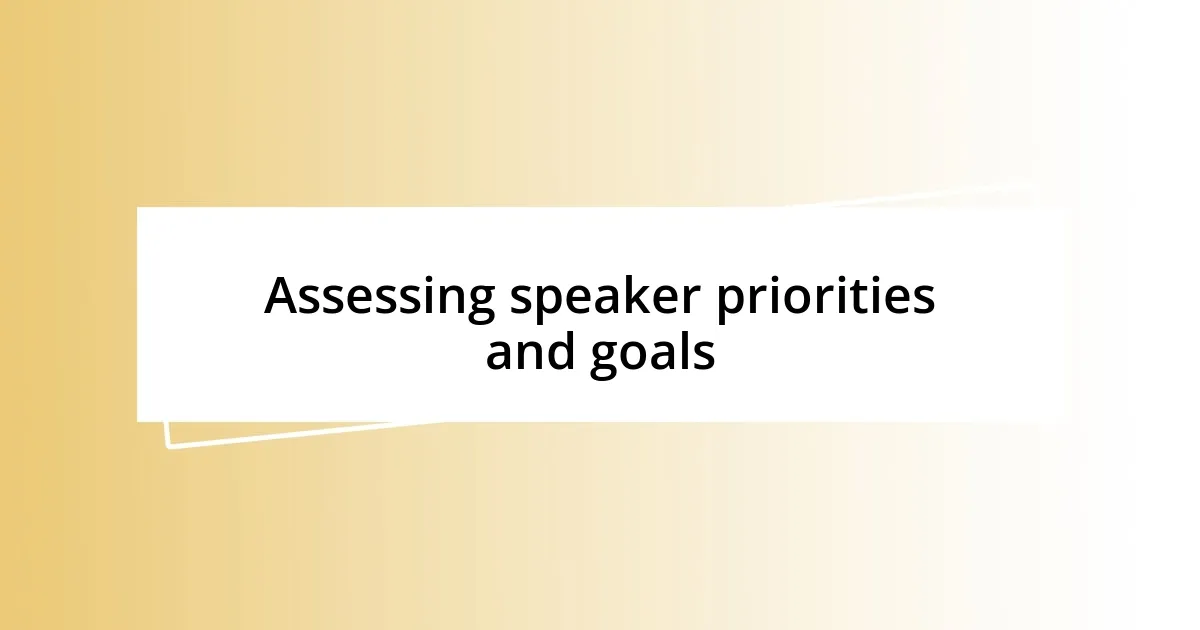
Assessing speaker priorities and goals
Assessing the priorities and goals of each speaker is an essential step when handling conflicting requests. I’ve found that understanding what drives a speaker’s passion can often illuminate the decision-making process. There was a time when two distinct speakers both wanted the same slot; one aimed to inspire a young audience with innovative ideas, while the other focused on sharing vital industry insights. Recognizing these unique objectives helped me make an informed choice that aligned with our event’s mission.
Here are some key factors I consider when assessing speaker priorities and goals:
- Audience Needs: Identifying who the primary audience is can shape which speaker would provide greater value.
- Content Relevance: Evaluating how relevant the speaker’s message is to the event’s theme or goals.
- Speaker Impact: Considering the potential impact of each speaker on the audience and how that aligns with the event’s objectives.
- Long-Term Relationships: Weighing the importance of cultivating ongoing relationships with speakers for future events.
- Unique Experiences: Reflecting on what unique perspective each speaker offers that could resonate with the audience.
Each of these factors holds significant weight, and I’ve learned that taking the time to assess them not only helps in making difficult choices but also builds trust and transparency with the speakers involved.
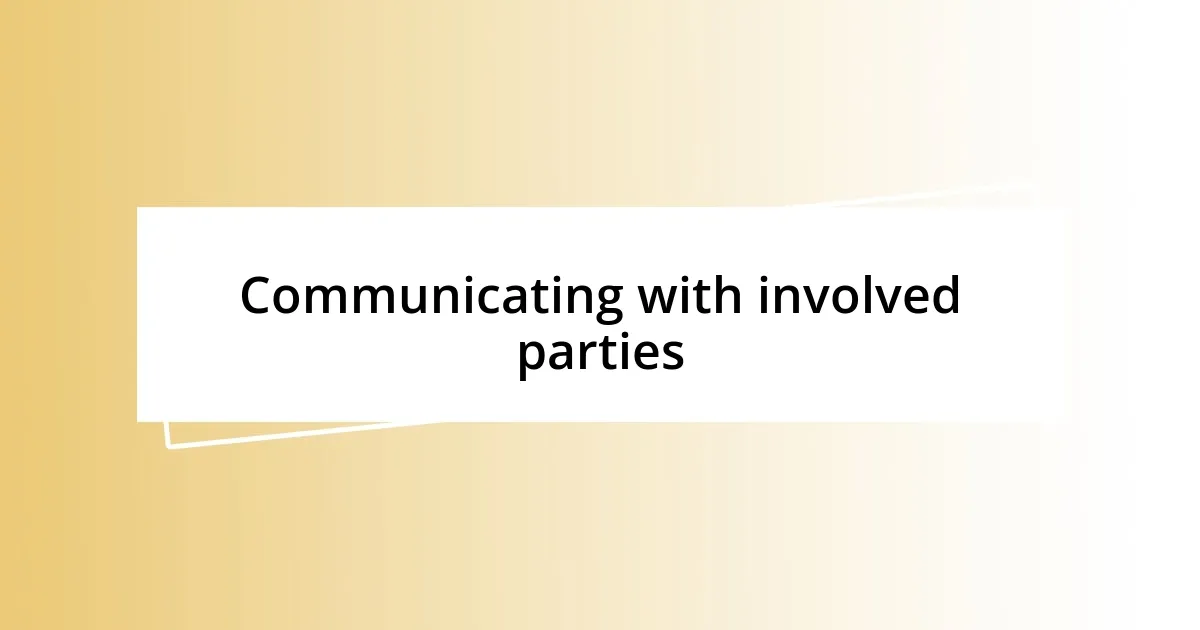
Communicating with involved parties
Effective communication with the involved parties is essential when dealing with speaker conflicts. I’ve had numerous conversations where transparency played a crucial role. For example, I once reached out to both speakers directly and laid out the situation honestly. Sharing my thought process and the criteria that led to certain choices made them feel valued. It’s interesting how open dialogues can shift the atmosphere from one of disappointment to understanding.
In another instance, engaging with the audience prior to the announcement helped me gauge their expectations. I asked them what they looked for in a speaker and why. This feedback was invaluable and fostered a sense of community. It also allowed me to address concerns before they became major issues. What a difference it makes to feel like everyone’s voice is heard, don’t you think?
Moreover, keeping an ongoing line of communication ensures that both speakers remain engaged and hopeful for future opportunities. I remember a time when I promised a talented speaker that I would keep them in mind for upcoming events, which helped maintain their enthusiasm despite losing the immediate opportunity. It’s all about relationships, and these connections are built on trust and clarity.
| Communication Strategy | Impact on Involved Parties |
|---|---|
| Transparency | Builds trust and understanding |
| Engagement | Fosters a sense of community and involvement |
| Ongoing Dialogue | Maintains relationships and future opportunities |
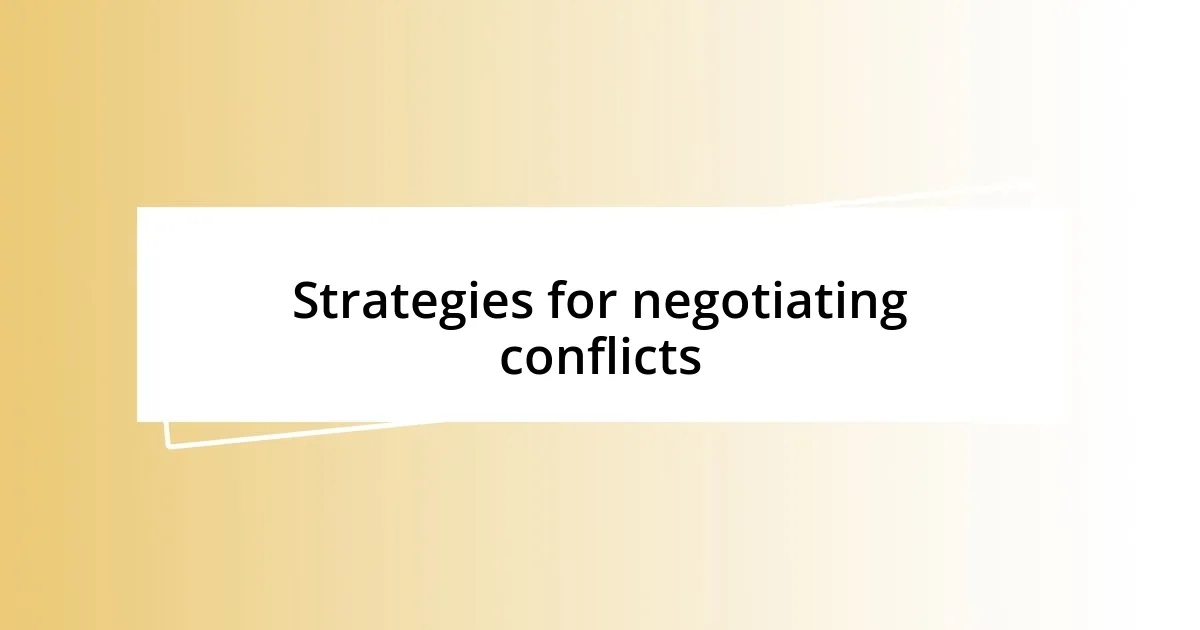
Strategies for negotiating conflicts
Finding common ground is crucial in negotiating conflicts between speakers. In a situation where two speakers had overlapping ideas, I facilitated a discussion where they could share their visions. This was enlightening; the synergy between them was palpable, and they found a way to combine their strengths into a cohesive message. Have you ever felt that thrill when collaboration leads to unexpected creativity? It’s one of the most rewarding aspects of my work.
When time permits, I advocate for a brainstorming session with the involved parties. This not only allows each speaker to express their expectations but also encourages them to suggest potential compromises. I experienced this firsthand when I invited two competing speakers into a room to hash things out. Watching them initially hesitant to share their ideas transform into enthusiastic collaborators reminded me how often we underestimate the power of direct communication.
Moreover, I always remind myself to stay focused on the bigger picture during negotiations. It’s easy to get bogged down in personal preferences, but I aim to keep the event’s overarching goals at the forefront. This was particularly evident to me during one event when a last-minute change in speakers tested my resolve. By emphasizing the importance of audience engagement over individual accolades, I navigated the situation with grace. Reflecting on that experience makes me realize how crucial it is to maintain perspective in challenging moments; wouldn’t you agree?
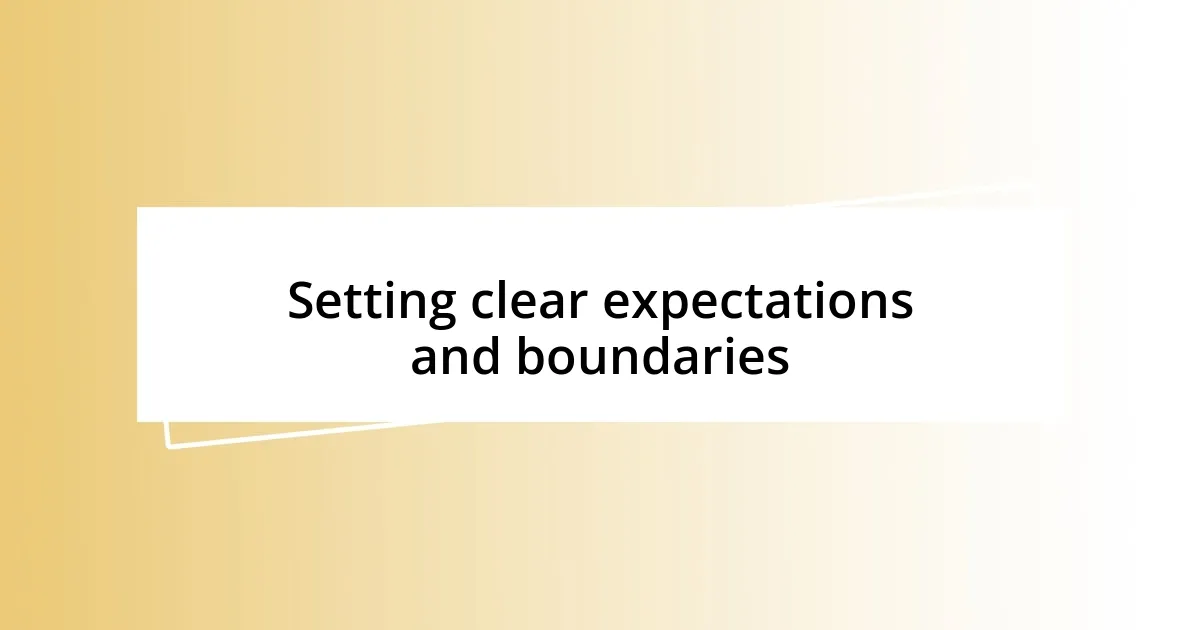
Setting clear expectations and boundaries
Setting clear expectations and boundaries is essential for reducing potential conflicts. I’ve learned that explicitly outlining what each speaker can expect in terms of time, audience engagement, and overall event structure not only provides clarity but also fosters a supportive environment. Once, I made it a point to lay out the specific roles and speaking times for two speakers with contrasting styles. This proactive approach helped them prepare accordingly and respect each other’s space.
Creating a written agreement or guideline can be incredibly beneficial. I recall a time when I drafted a simple document summarizing our discussions—it included the main topics, time allocations, and even each speaker’s objectives. Sharing this not only kept everyone on the same page but also gave both speakers a feeling of ownership in the process. Have you ever noticed how having something in writing can ease anxiety?
Moreover, I always find it helpful to revisit those expectations as the event approaches. Just recently, I touched base with speakers to confirm their comfort with the agenda and adjust any final details. This final check-in worked wonders for aligning our goals while making them feel reassured and respected. It’s remarkable how setting clear expectations and boundaries can pave the way toward a more harmonious collaboration, don’t you think?
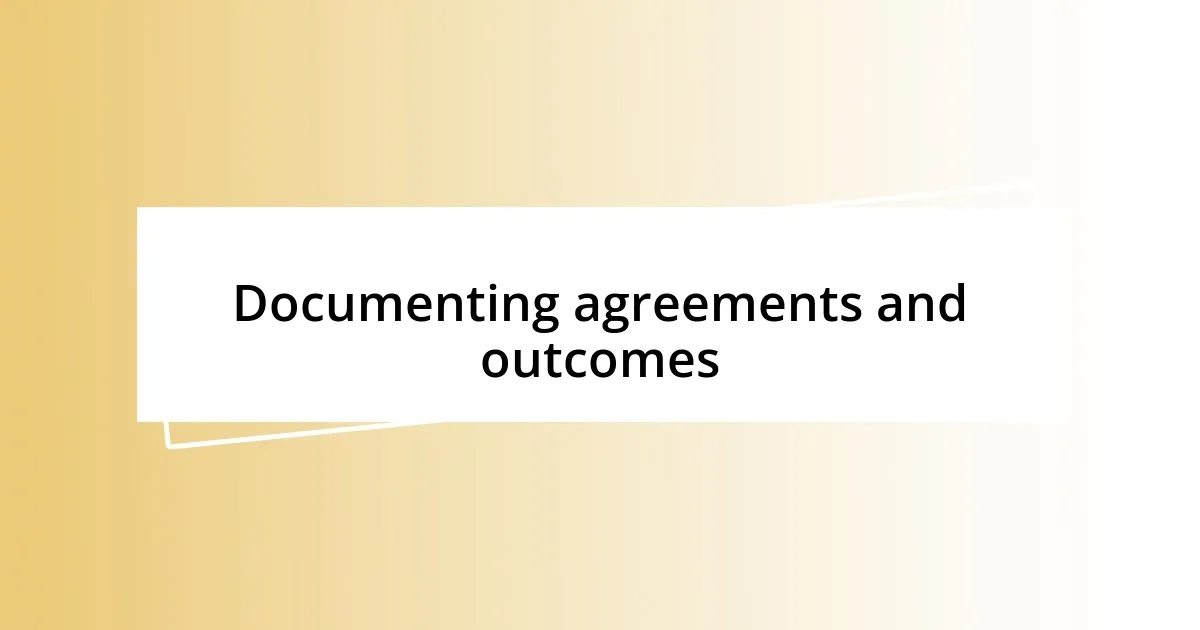
Documenting agreements and outcomes
Documenting agreements and outcomes is a vital step I never overlook. After discussions, I always take a moment to summarize the key points that emerged, which fosters a sense of accountability among speakers. I remember a time when I compiled a simple checklist covering talking points and expectations; it settled any uncertainties and left both speakers feeling validated. Isn’t it reassuring to have everything in writing?
In my experience, revisiting documentation before the event can be transformative. During one particular event, I sent out a brief outline of our agreements a week in advance. The response was overwhelmingly positive; the speakers appreciated the reminder and felt more connected to the event’s objectives. It struck me then how something as straightforward as an email can cultivate confidence and cohesiveness among participants.
One strategy I find particularly effective is to schedule a post-event debrief. It allows speakers to reflect on how the agreements played out in practice. I vividly recall a debrief session where both speakers expressed their surprise at how well the documented outcomes translated into audience engagement. Isn’t it fascinating how reflecting on agreements can uncover new insights and improvements for future collaborations?












